Isomerization of Glucose to Fructose in Hydrolysates from Lignocellulosic Biomass Using Hydrotalcite
Abstract
1. Introduction
2. Materials and Methods
2.1. Obtaining a Glucose-Containing Hydrolysate from Lignocellulosic Biomass
2.2. Isomerization Experiments
2.3. Analytics
3. Results and Discussion
3.1. Glucose Isomerization under pH-Neutral Conditions
3.2. Glucose Isomerization under pH-Acidic Conditions
3.3. Isomerization of Hydrolysate from Lignocellulose without Previous Neutralization
3.4. Isomerization of Hydrolysate from Lignocellulose after Previous Neutralization
4. Conclusions
Author Contributions
Funding
Acknowledgments
Conflicts of Interest
References
- Steinbach, D.; Kruse, A.; Sauer, J. Pretreatment technologies of lignocellulosic biomass in water in view of furfural and 5-hydroxymethylfurfural production—A review. Biomass Convers. Biorefinery 2017, 7, 247–274. [Google Scholar] [CrossRef]
- Van Putten, R.J.; van der Waal, J.C.; de Jong, E.; Rasrendra, C.B.; Heeres, H.J.; de Vries, J.G. Hydroxymethylfurfural, a versatile platform chemical made from renewable resources. Chem. Rev. 2013, 113, 1499–1597. [Google Scholar] [CrossRef]
- Steinbach, D.; Kruse, A.; Sauer, J.; Vetter, P. Sucrose Is a Promising Feedstock for the Synthesis of the Platform Chemical Hydroxymethylfurfural. Energies 2018, 11, 645. [Google Scholar] [CrossRef]
- Bhosale, S.H.; Rao, M.B.; Deshpande, V.V. Molecular and industrial aspects of glucose isomerase. Microbiol. Rev. 1996, 60, 280. [Google Scholar] [CrossRef]
- Tewari, Y.B. Thermodynamics of industrially-important, enzyme-catalyzed reactions. Appl. Biochem. Biotech. 1990, 23, 187–203. [Google Scholar] [CrossRef]
- Roman-Leshkov, Y.; Moliner, M.; Labinger, J.A.; Davis, M.E. Mechanism of Glucose Isomerization Using a Solid Lewis Acid Catalyst in Water. Angew. Chem. Int. Edit. 2010, 49, 8954–8957. [Google Scholar] [CrossRef]
- Bermejo-Deval, R.; Assary, R.S.; Nikolla, E.; Moliner, M.; Román-Leshkov, Y.; Hwang, S.-J.; Palsdottir, A.; Silverman, D.; Lobo, R.F.; Curtiss, L.A.; et al. Metalloenzyme-like catalyzed isomerizations of sugars by Lewis acid zeolites. Proc. Natl. Acad. Sci. USA 2012, 109, 9727–9732. [Google Scholar] [CrossRef]
- Allen, K.N.; Lavie, A.; Farber, G.K.; Glasfeld, A.; Petsko, G.A.; Ringe, D. Isotopic Exchange plus Substrate and Inhibition Kinetics of D-Xylose Isomerase Do Not Support a Proton-Transfer Mechanism. Biochemistry 1994, 33, 1481–1487. [Google Scholar] [CrossRef]
- Kovalevsky, A.Y.; Hanson, L.; Fisher, S.Z.; Mustyakimov, M.; Mason, S.A.; Trevor Forsyth, V.; Blakeley, M.P.; Keen, D.A.; Wagner, T.; Carrell, H.L.; et al. Metal Ion Roles and the Movement of Hydrogen during Reaction Catalyzed by D-Xylose Isomerase: A Joint X-Ray and Neutron Diffraction Study. Structure 2010, 18, 688–699. [Google Scholar] [CrossRef]
- Usuki, C.; Kimura, Y.; Adachi, S. Isomerization of Hexoses in Subcritical Water. Food Sci. Technol. Res. 2007, 13, 205–209. [Google Scholar] [CrossRef]
- Delidovich, I.; Palkovits, R. Catalytic Isomerization of Biomass-Derived Aldoses: A Review. Chemsuschem 2016, 9, 547–561. [Google Scholar] [CrossRef]
- Li, B.; Li, L.; Zhang, Q.; Weng, W.; Wan, H. Attapulgite as natural catalyst for glucose isomerization to fructose in water. Catal Commun. 2017, 99, 20–24. [Google Scholar] [CrossRef]
- Marianou, A.A.; Michailof, C.M.; Pineda, A.; Iliopoulou, E.F.; Triantafyllidis, K.S.; Lappas, A.A. Glucose to Fructose Isomerization in Aqueous Media over Homogeneous and Heterogeneous Catalysts. Chemcatchem 2016, 8, 1100–1110. [Google Scholar] [CrossRef]
- Cantrell, D.G.; Gillie, L.J.; Lee, A.F.; Wilson, K. Structure-reactivity correlations in MgAl hydrotalcite catalysts for biodiesel synthesis. Appl. Catal. A Gen. 2005, 287, 183–190. [Google Scholar] [CrossRef]
- Lecomte, J.; Finiels, A.; Moreau, C. Kinetic study of the isomerization of glucose into fructose in the presence of anion-modified hydrotalcites. Starch-Starke 2002, 54, 75–79. [Google Scholar] [CrossRef]
- Delidovich, I.; Palkovits, R. Structure-performance correlations of Mg-Al hydrotalcite catalysts for the isomerization of glucose into fructose. J. Catal. 2015, 327, 1–9. [Google Scholar] [CrossRef]
- Yu, S.; Kim, E.; Park, S.; Song, I.K.; Jung, J.C. Isomerization of glucose into fructose over Mg-Al hydrotalcite catalysts. Catal. Commun. 2012, 29, 63–67. [Google Scholar] [CrossRef]
- Delidovich, I.; Palkovits, R. Catalytic activity and stability of hydrophobic Mg-Al hydrotalcites in the continuous aqueous-phase isomerization of glucose into fructose. Catal. Sci. Technol. 2014, 4, 4322–4329. [Google Scholar] [CrossRef]
- Moreau, C.; Durand, R.; Roux, A.; Tichit, D. Isomerization of glucose into fructose in the presence of cation-exchanged zeolites and hydrotalcites. Appl. Catal. A Gen. 2000, 193, 257–264. [Google Scholar] [CrossRef]
- Weisgerber, L.; Palkovits, S.; Palkovits, R. Development of a reactor setup for continuous dehydration of carbohydrates. Chem.-Ing-Tech. 2013, 85, 512–515. [Google Scholar] [CrossRef]
- Souzanchi, S.; Nazari, L.; Rao, K.T.V.; Yuan, Z.; Tan, Z.; Xu, C. Catalytic isomerization of glucose to fructose using heterogeneous solid Base catalysts in a continuous-flow tubular reactor: Catalyst screening study. Catal. Today 2019, 319, 76–83. [Google Scholar] [CrossRef]
- Yabushita, M.; Shibayama, N.; Nakajima, K.; Fukuoka, A. Selective Glucose-to-Fructose Isomerization in Ethanol Catalyzed by Hydrotalcites. ACS Catal. 2019, 9, 2101–2109. [Google Scholar] [CrossRef]
- Lee, G.; Kang, J.Y.; Yan, N.; Suh, Y.-W.; Jung, J.C. Simple preparation method for Mg–Al hydrotalcites as base catalysts. J. Mol. Catal. A Chem. 2016, 423, 347–355. [Google Scholar] [CrossRef]
- Kang, J.; Lee, G.; Suh, Y.-W.; Jung, J. Effect of Mg/Al Atomic Ratio of Mg-Al Hydrotalcites on Their Catalytic Properties for the Isomerization of Glucose to Fructose. J. Nanosci. Nanotechnol. 2017, 17, 8242–8247. [Google Scholar] [CrossRef]
- Park, S.; Kwon, D.; Kang, J.Y.; Jung, J.C. Influence of the preparation method on the catalytic activity of MgAl hydrotalcites as solid base catalysts. Green Energy Environ. 2019, 4, 287–292. [Google Scholar] [CrossRef]
- Murzin, D.Y.; Murzina, E.V.; Aho, A.; Kazakova, M.A.; Selyutin, A.G.; Kubicka, D.; Kuznetsov, V.L.; Simakova, I.L. Aldose to ketose interconversion: Galactose and arabinose isomerization over heterogeneous catalysts. Catal. Sci. Technol. 2017, 7, 5321–5331. [Google Scholar] [CrossRef]
- Upare, P.P.; Chamas, A.; Lee, J.H.; Kim, J.C.; Kwak, S.K.; Hwang, Y.K.; Hwang, D.W. Highly Efficient Hydrotalcite/1-Butanol Catalytic System for the Production of the High-Yield Fructose Crystal from Glucose. ACS Catal. 2020, 10, 1388–1396. [Google Scholar] [CrossRef]
- Antal, M.J.; Mok, W.S.L.; Richards, G.N. Mechanism of formation of 5-(hydroxymethyl)-2-furaldehyde from d-fructose and sucrose. Carbohydr. Res. 1990, 199, 91–109. [Google Scholar] [CrossRef]
- Asghari, F.S.; Yoshida, H. Acid-catalyzed production of 5-hydroxymethyl furfural from D-fructose in subcritical water. Ind Eng. Chem. Res. 2006, 45, 2163–2173. [Google Scholar] [CrossRef]
- Świątek, K.; Gaag, S.; Klier, A.; Kruse, A.; Sauer, J.; Steinbach, D. Acid Hydrolysis of Lignocellulosic Biomass: Sugars and Furfurals Formation. Catalysts 2020, 10, 437. [Google Scholar] [CrossRef]
- Xie, W.; Peng, H.; Chen, L. Calcined Mg–Al hydrotalcites as solid base catalysts for methanolysis of soybean oil. J. Mol. Catal. A Chem. 2006, 246, 24–32. [Google Scholar] [CrossRef]
- Souza, R.O.L.; Fabiano, D.P.; Feche, C.; Rataboul, F.; Cardoso, D.; Essayem, N. Glucose-fructose isomerisation promoted by basic hybrid catalysts. Catal. Today 2012, 195, 114–119. [Google Scholar] [CrossRef]
- Wiyantoko, B.; Kurniawati, P.; Purbaningtias, T.E.; Fatimah, I. Synthesis and Characterization of Hydrotalcite at Different Mg/Al Molar Ratios. Procedia Chem. 2015, 17, 21–26. [Google Scholar] [CrossRef]
- Hernandez-Moreno, M.J.; Ulibarri, M.A.; Rendon, J.L.; Serna, C.J. IR characteristics of hydrotalcite-like compounds. Phys. Chem. Miner. 1985, 12, 34–38. [Google Scholar] [CrossRef]
- Frost, R.L.; Scholz, R.; López, A.; Theiss, F.L. Vibrational spectroscopic study of the natural layered double hydroxide manasseite now defined as hydrotalcite-2H–Mg6Al2(OH)16[CO3]⋅4H2O. Spectrochim. Acta Part. A Mol. Biomol. Spectrosc. 2014, 118, 187–191. [Google Scholar] [CrossRef]
- Cavani, F.; Trifirò, F.; Vaccari, A. Hydrotalcite-type anionic clays: Preparation, properties and applications. Catal. Today 1991, 11, 173–301. [Google Scholar] [CrossRef]
- Pérez-Ramírez, J.; Abelló, S.; van der Pers, N.M. Influence of the Divalent Cation on the Thermal Activation and Reconstruction of Hydrotalcite-like Compounds. J. Phys. Chem. C 2007, 111, 3642–3650. [Google Scholar] [CrossRef]
- Pérez-Ramírez, J.; Abelló, S.; van der Pers, N.M. Memory Effect of Activated Mg–Al Hydrotalcite: In Situ XRD Studies during Decomposition and Gas-Phase Reconstruction. Chem. A Eur. J. 2007, 13, 870–878. [Google Scholar] [CrossRef]
- Bageri, B.S.; Mahmoud, M.A.; Shawabkeh, R.A.; Abdulraheem, A. Evaluation of Barium Sulfate (Barite) Solubility Using Different Chelating Agents at a High Temperature. J. Pet. Sci. Technol. 2017, 7, 42–56. [Google Scholar] [CrossRef]
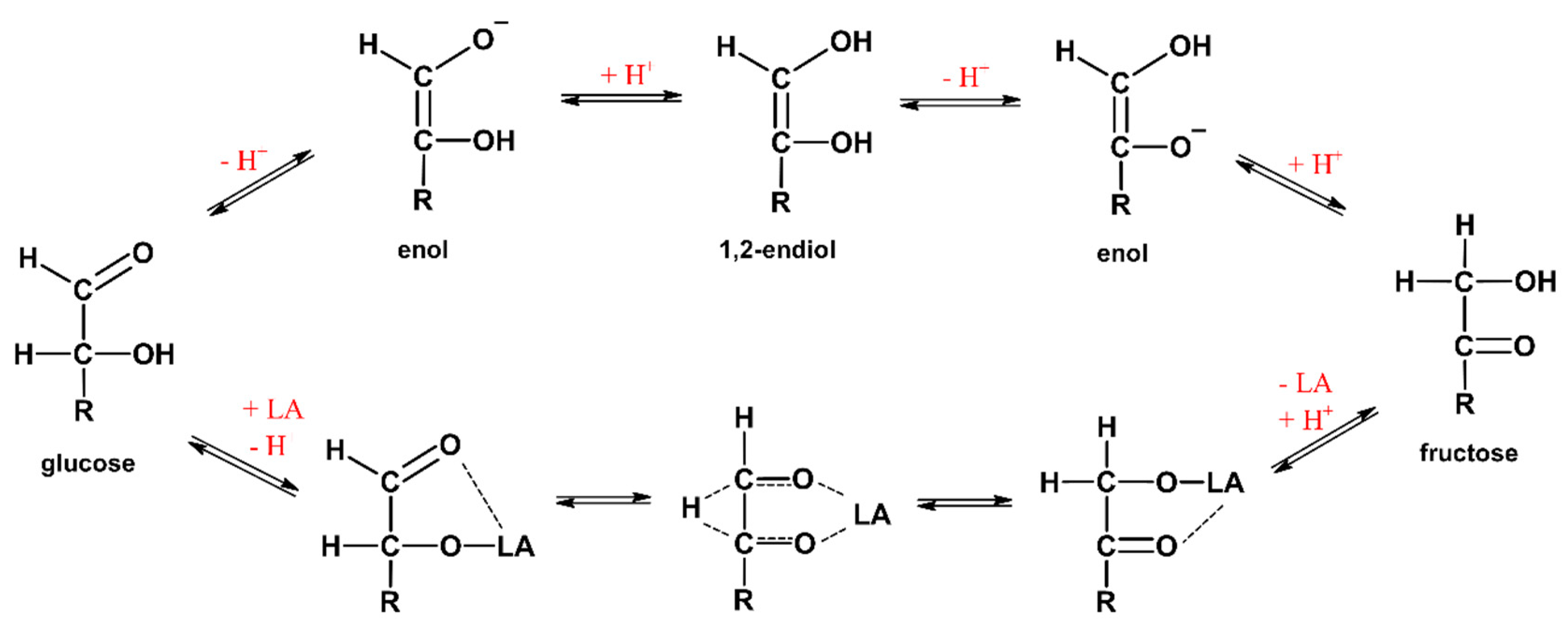
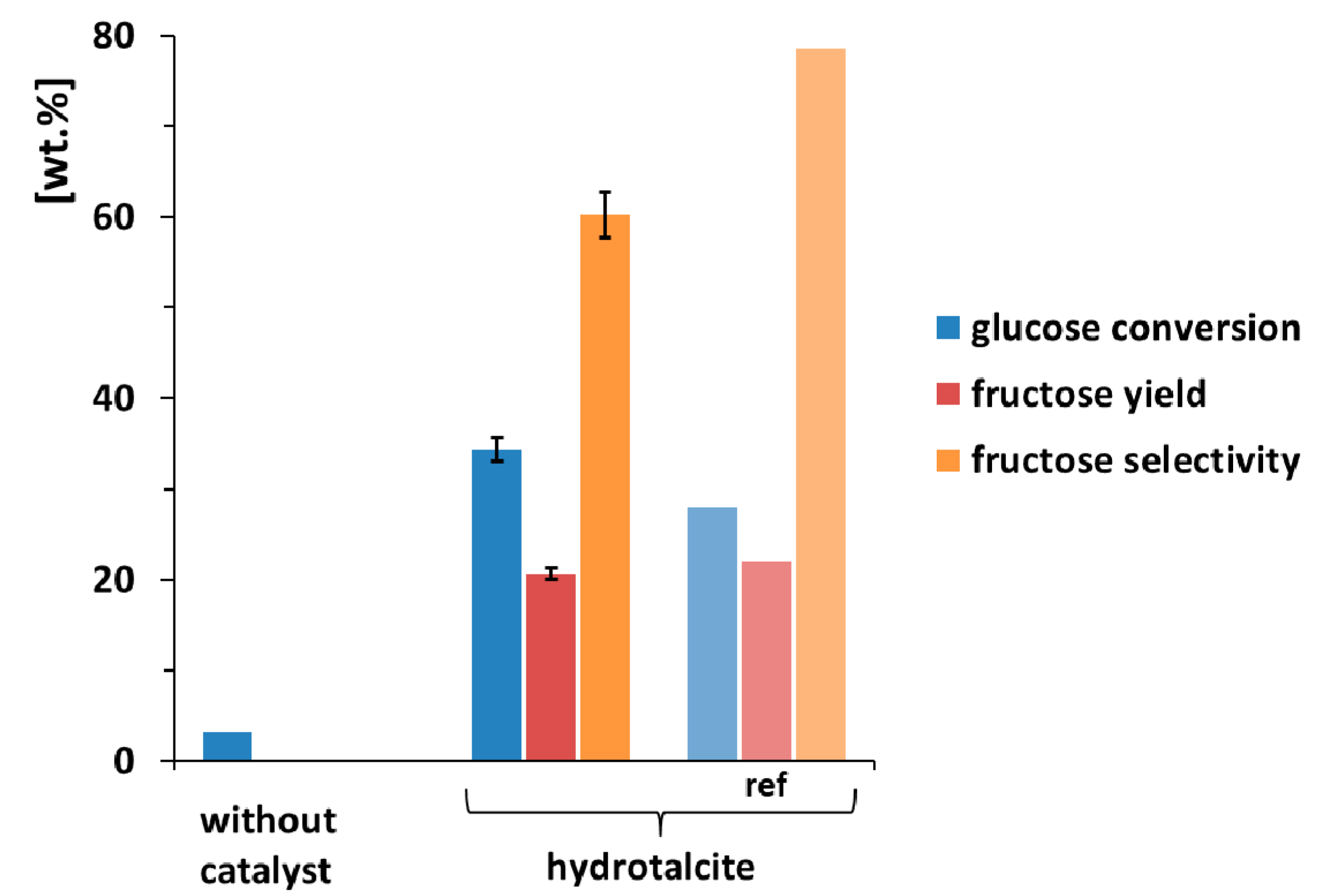
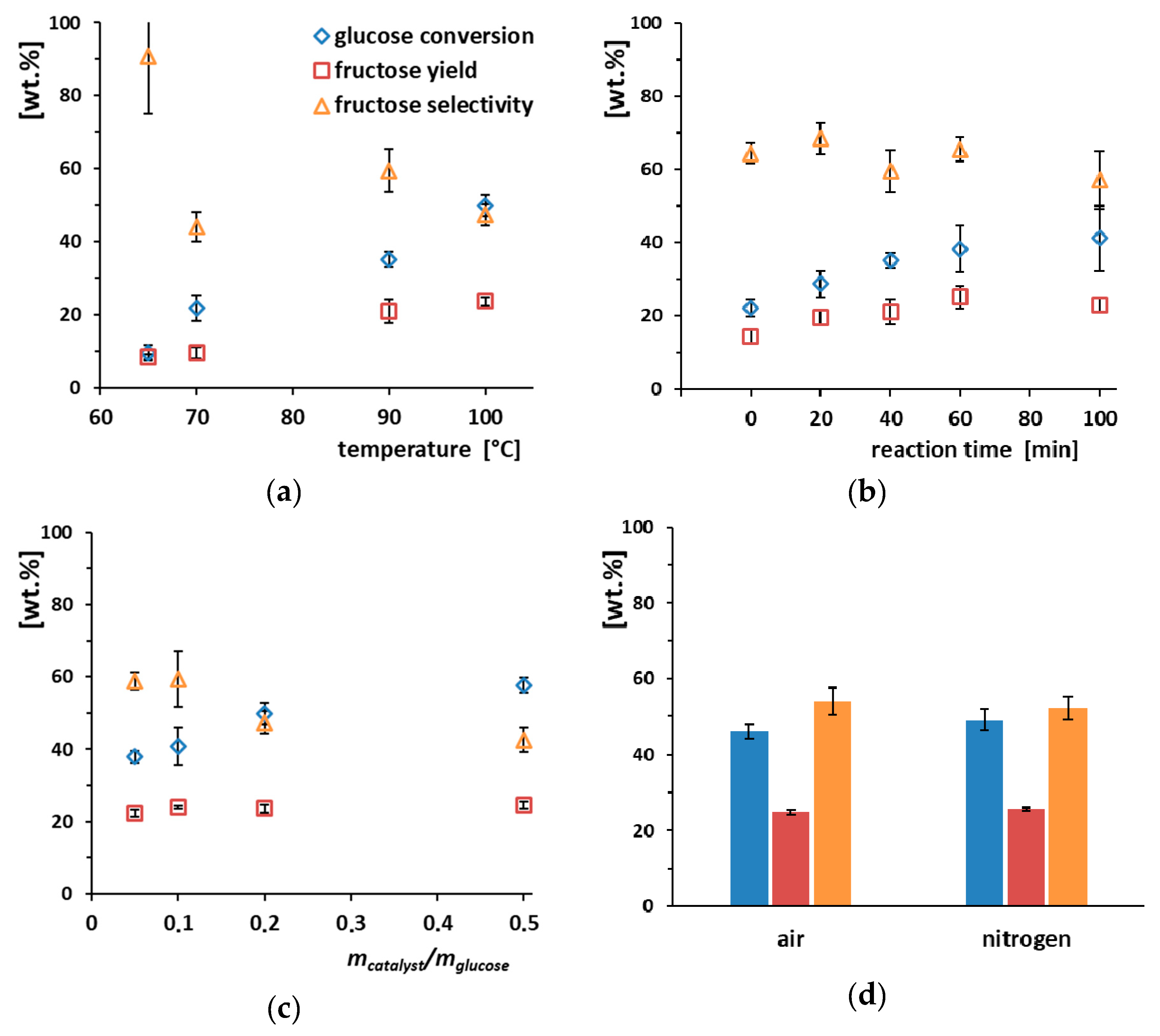
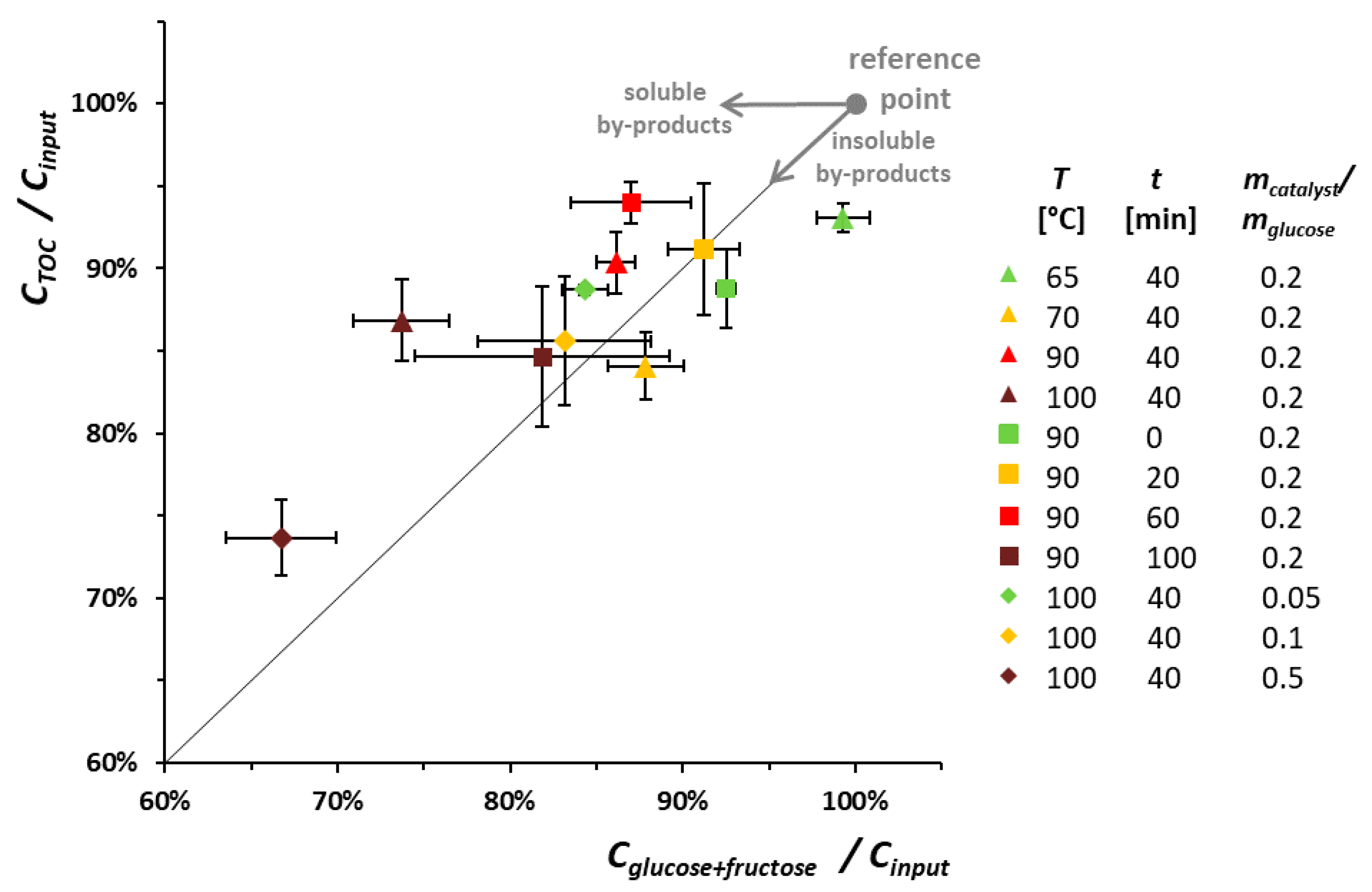
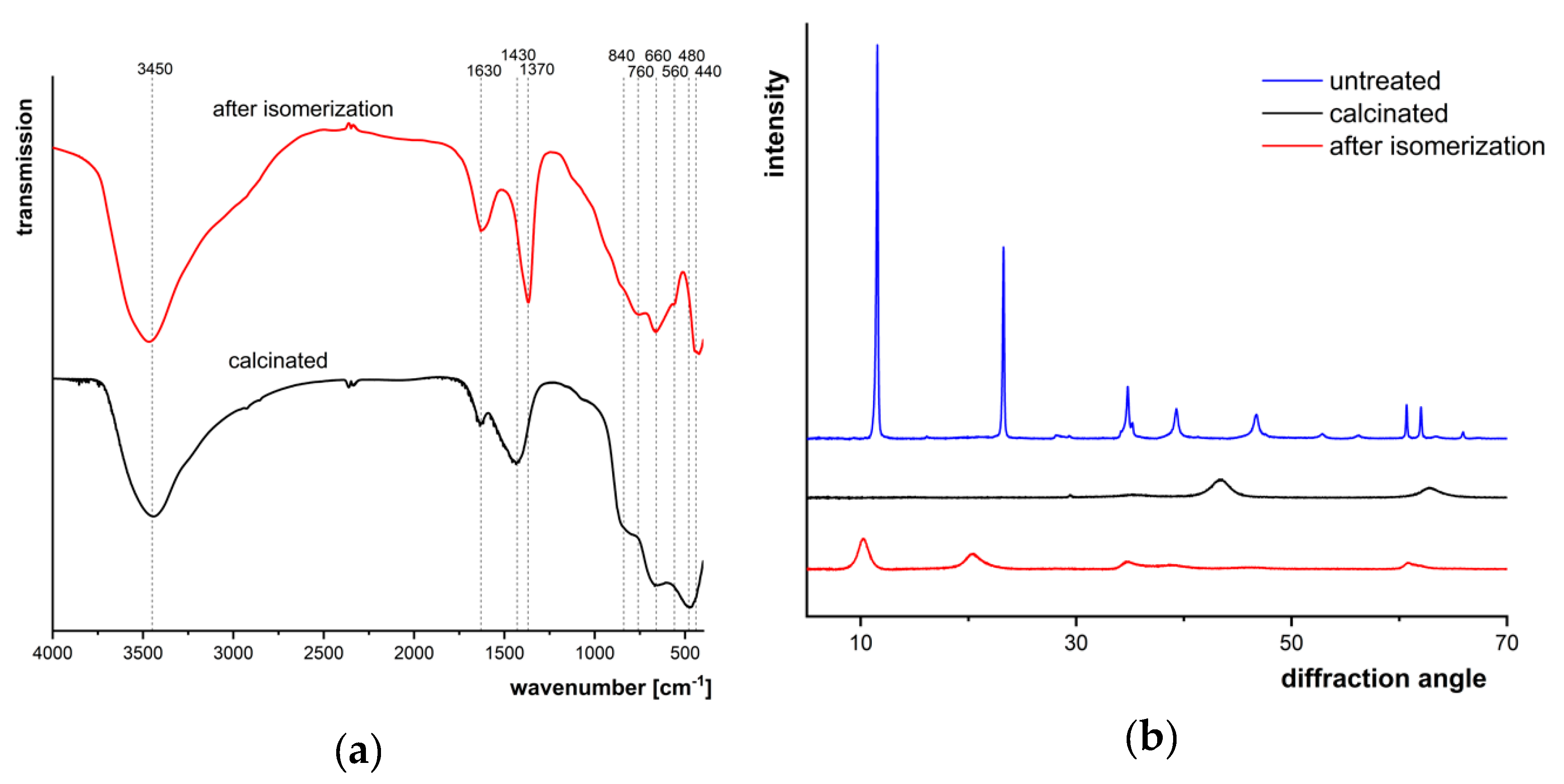
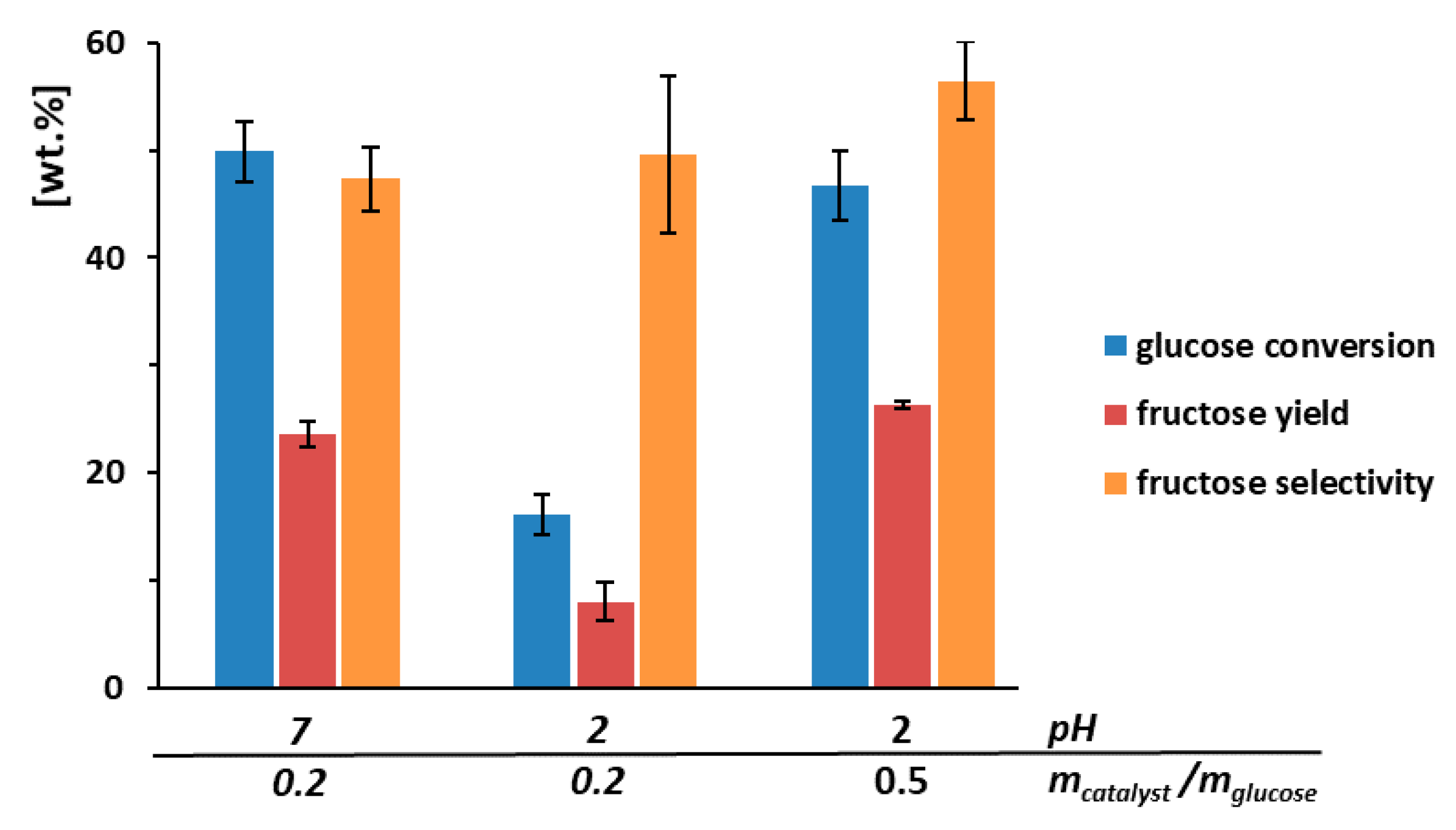

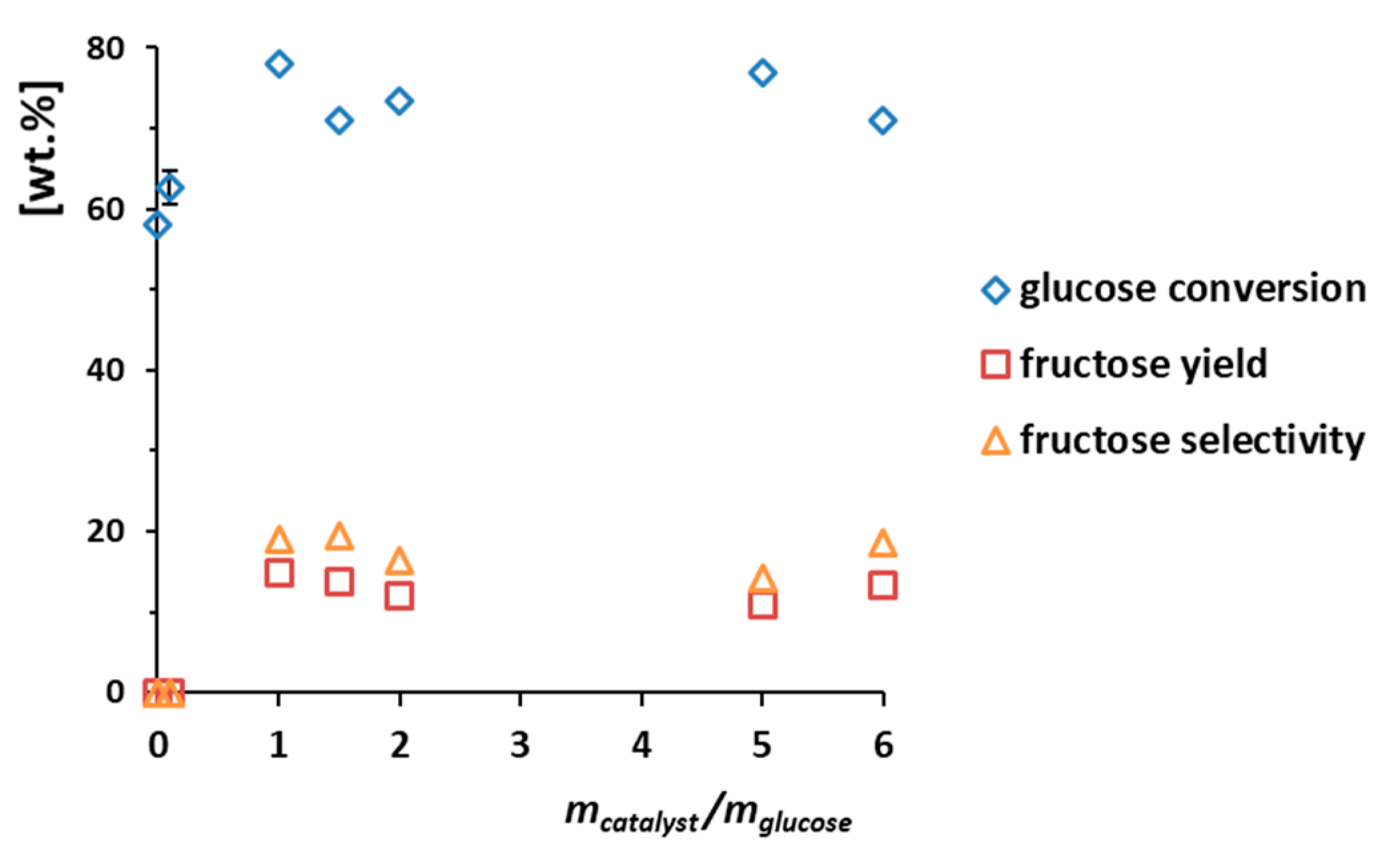
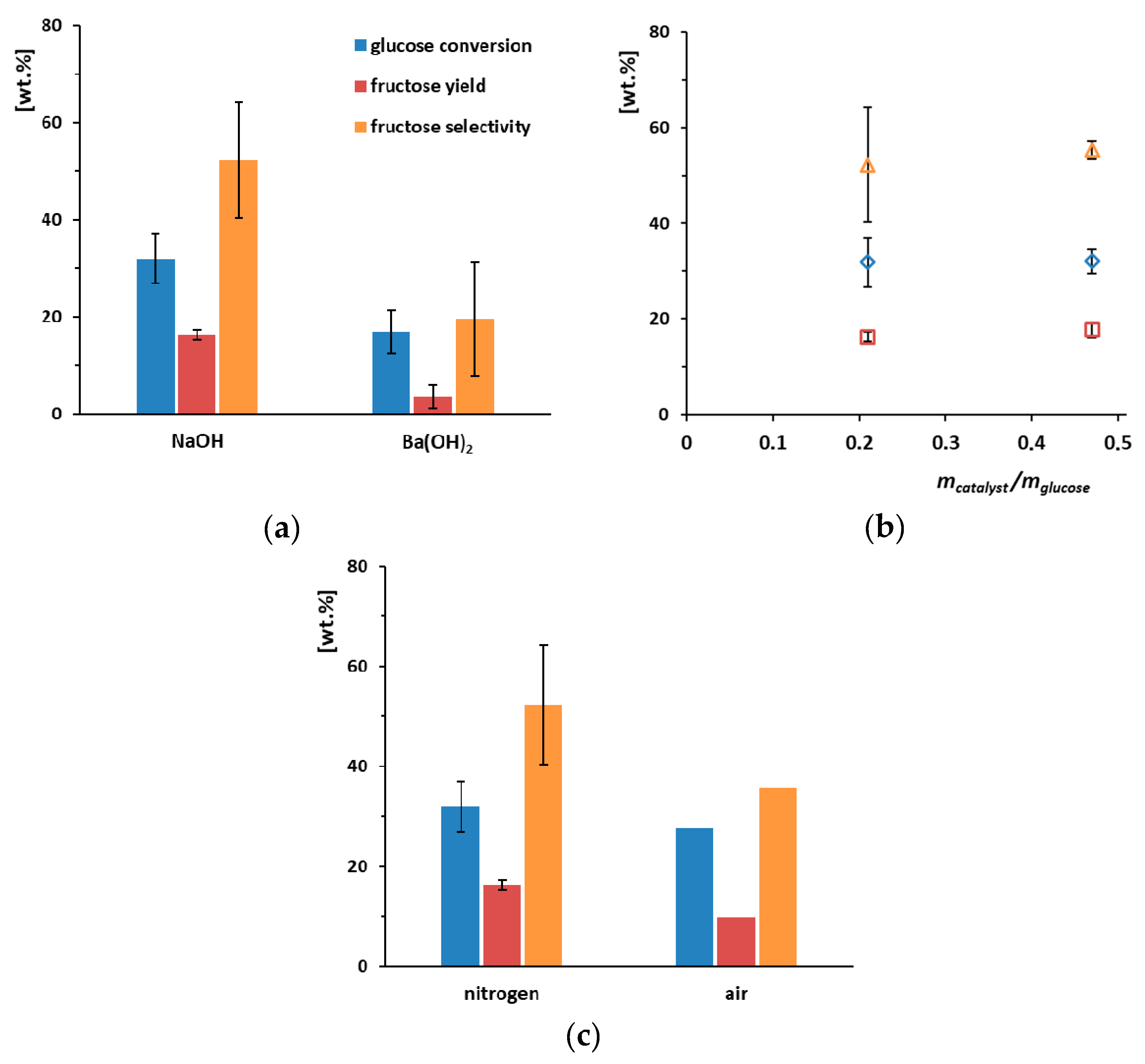
| Temperature [°C] | Reaction Time [min] | Glucose Conversion [wt.%] | Fructose Selectivity [wt.%] | Fructose Yield [wt.%] | Ref |
|---|---|---|---|---|---|
| 90 | 60 | 28 | 78 | 22 | [15] |
| 90 | 120 | 41 | 75 | 31 | [18] |
| 110 | 180 | 34 | 89 | 30 | [16] |
| 95 | ? | 42 | 60 | 25 | [19] |
| 120 | 60 | 43 | 64 | 27 | [20] |
| 100 | ? | 18 | 78 | 14 | [21] |
| 90 | 120 | 61 | 83 | 50 | [22] |
| 100 | 300 | 27 | 74 | 20 | [23] |
| 100 | 300 | 61 | 70 | 42 | [24] |
| 100 | 180 | 38 | 66 | 25 | [25] |
| 120 | 240 | 36 | 75 | 27 | [26] |
| 100 | 300 | 54 | 56 | 30 | [27] |
© 2020 by the authors. Licensee MDPI, Basel, Switzerland. This article is an open access article distributed under the terms and conditions of the Creative Commons Attribution (CC BY) license (http://creativecommons.org/licenses/by/4.0/).
Share and Cite
Steinbach, D.; Klier, A.; Kruse, A.; Sauer, J.; Wild, S.; Zanker, M. Isomerization of Glucose to Fructose in Hydrolysates from Lignocellulosic Biomass Using Hydrotalcite. Processes 2020, 8, 644. https://doi.org/10.3390/pr8060644
Steinbach D, Klier A, Kruse A, Sauer J, Wild S, Zanker M. Isomerization of Glucose to Fructose in Hydrolysates from Lignocellulosic Biomass Using Hydrotalcite. Processes. 2020; 8(6):644. https://doi.org/10.3390/pr8060644
Chicago/Turabian StyleSteinbach, David, Andreas Klier, Andrea Kruse, Jörg Sauer, Stefan Wild, and Marina Zanker. 2020. "Isomerization of Glucose to Fructose in Hydrolysates from Lignocellulosic Biomass Using Hydrotalcite" Processes 8, no. 6: 644. https://doi.org/10.3390/pr8060644
APA StyleSteinbach, D., Klier, A., Kruse, A., Sauer, J., Wild, S., & Zanker, M. (2020). Isomerization of Glucose to Fructose in Hydrolysates from Lignocellulosic Biomass Using Hydrotalcite. Processes, 8(6), 644. https://doi.org/10.3390/pr8060644






